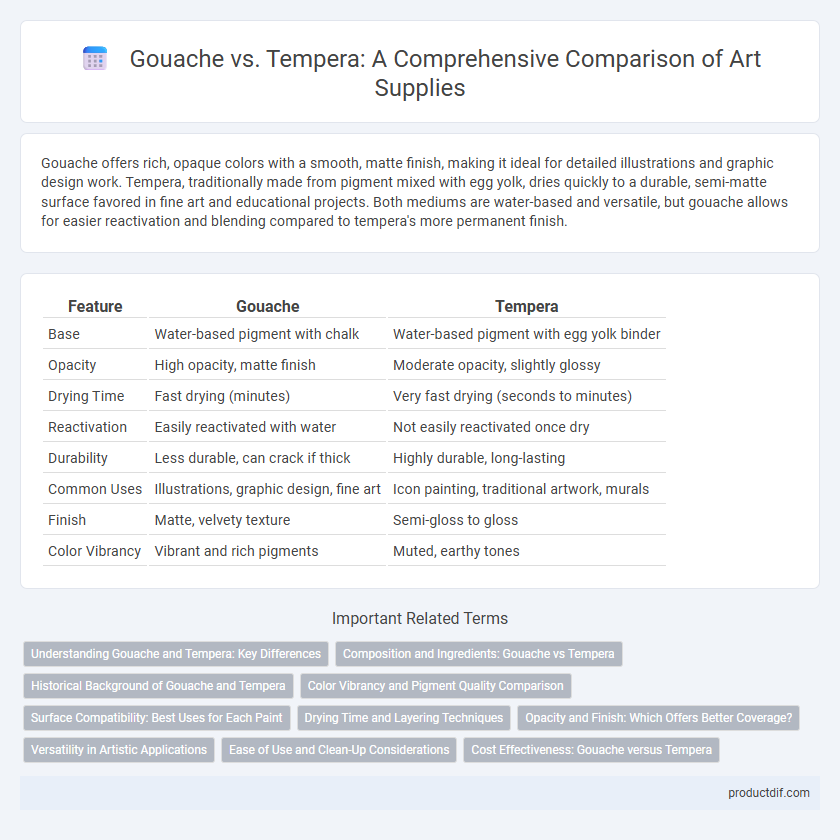Gouache offers rich, opaque colors with a smooth, matte finish, making it ideal for detailed illustrations and graphic design work. Tempera, traditionally made from pigment mixed with egg yolk, dries quickly to a durable, semi-matte surface favored in fine art and educational projects. Both mediums are water-based and versatile, but gouache allows for easier reactivation and blending compared to tempera's more permanent finish.
Table of Comparison
| Feature | Gouache | Tempera |
|---|---|---|
| Base | Water-based pigment with chalk | Water-based pigment with egg yolk binder |
| Opacity | High opacity, matte finish | Moderate opacity, slightly glossy |
| Drying Time | Fast drying (minutes) | Very fast drying (seconds to minutes) |
| Reactivation | Easily reactivated with water | Not easily reactivated once dry |
| Durability | Less durable, can crack if thick | Highly durable, long-lasting |
| Common Uses | Illustrations, graphic design, fine art | Icon painting, traditional artwork, murals |
| Finish | Matte, velvety texture | Semi-gloss to gloss |
| Color Vibrancy | Vibrant and rich pigments | Muted, earthy tones |
Understanding Gouache and Tempera: Key Differences
Gouache and tempera are both water-based paints but differ significantly in composition and finish; gouache contains pigment, water, and a chalk-like additive for opacity, creating a matte, vibrant finish ideal for illustrations and design work. Tempera, traditionally made with pigment mixed with egg yolk or a binder, produces a durable, fast-drying paint with a slightly translucent, matte surface suited for fine art and historical restoration. Understanding these key differences helps artists choose the right medium based on texture, drying time, and color vibrancy preferences.
Composition and Ingredients: Gouache vs Tempera
Gouache is a water-based paint composed of pigment, water, a binding agent like gum arabic, and inert white fillers that create its opaque, matte finish. Tempera paint typically consists of pigment mixed with a water-soluble binder such as egg yolk, resulting in a fast-drying, durable medium favored for fine detail and longevity. The key difference in ingredients lies in gouache's use of synthetic binders and fillers, while tempera relies on natural emulsions, influencing their texture, opacity, and adhesion properties.
Historical Background of Gouache and Tempera
Gouache, a water-based paint known for its opaque qualities, traces its origins to ancient times, with usage documented in Egyptian tomb paintings and medieval manuscripts. Tempera, developed earlier in antiquity, relies on egg yolk as a binder and was the dominant medium for panel painting during the Italian Renaissance, prized for its fast-drying and durable properties. Both mediums significantly influenced art history, with Gouache evolving to offer vibrant, matte finishes ideal for illustration, while Tempera maintained a legacy in fine art through detailed, long-lasting works.
Color Vibrancy and Pigment Quality Comparison
Gouache offers superior color vibrancy due to its high pigment concentration and opaque qualities, making it ideal for bold, bright artworks. Tempera, traditionally made from pigment mixed with egg yolk, provides a matte finish with less intense pigmentation but excellent durability and quick drying times. The pigment quality in gouache ensures more consistent and vivid hues, while tempera's organic binder can result in subtle variations and a softer color palette.
Surface Compatibility: Best Uses for Each Paint
Gouache offers superior adhesion and vibrancy on smooth surfaces such as illustration board, watercolor paper, and prepared canvas, making it ideal for graphic design and fine art projects. Tempera performs best on porous surfaces like wood panels, papier-mache, and unprimed paper, where its quick-drying and matte finish complement craft and educational applications. Understanding the surface compatibility of gouache and tempera ensures optimal paint performance and durability in diverse artistic techniques.
Drying Time and Layering Techniques
Gouache dries faster than tempera, typically within 15-30 minutes, allowing artists to apply multiple layers quickly without disturbing underlying paint. Tempera, with a longer drying time of up to an hour, requires careful drying between layers to prevent lifting and mixing of colors. Both mediums support building opacity through layering, but gouache's faster drying enhances efficiency in detailed, multi-layered artwork.
Opacity and Finish: Which Offers Better Coverage?
Gouache provides superior opacity due to its high pigment concentration and fine chalk particles, resulting in a smooth, matte finish that covers underlying layers effectively. Tempera, traditionally made with pigment and egg yolk, offers a more translucent finish with less coverage, requiring multiple layers for solid opacity. For projects needing vibrant, opaque coverage and a matte appearance, gouache is the preferred choice over tempera.
Versatility in Artistic Applications
Gouache offers greater versatility in artistic applications due to its ability to be reactivated with water after drying, allowing for layering and adjustments multiple times. Tempera, traditionally made with egg yolk, dries quickly to a durable, matte finish but is less forgiving for blending or reworking once set. Artists often choose gouache for mixed media projects and fine detail work, while tempera excels in frescoes and rigid surfaces where permanence is key.
Ease of Use and Clean-Up Considerations
Gouache offers a smooth, opaque texture that reactivates with water, allowing easy corrections and simple clean-up using just soap and water. Tempera, often found in stick or powder form, dries quickly but can be harder to rework or remove once set, requiring more careful handling during application. Both mediums are non-toxic, but gouache typically provides a more user-friendly experience for beginners due to its forgiving nature and straightforward clean-up process.
Cost Effectiveness: Gouache versus Tempera
Gouache offers cost effectiveness through its high pigment concentration, requiring less paint for vibrant coverage compared to tempera. Tempera, typically affordable but less concentrated, may demand frequent reapplication or larger quantities for similar opacity. Artists seeking budget-friendly, richly pigmented media often find gouache provides better value per milliliter than traditional tempera paints.
Gouache vs Tempera Infographic

 productdif.com
productdif.com